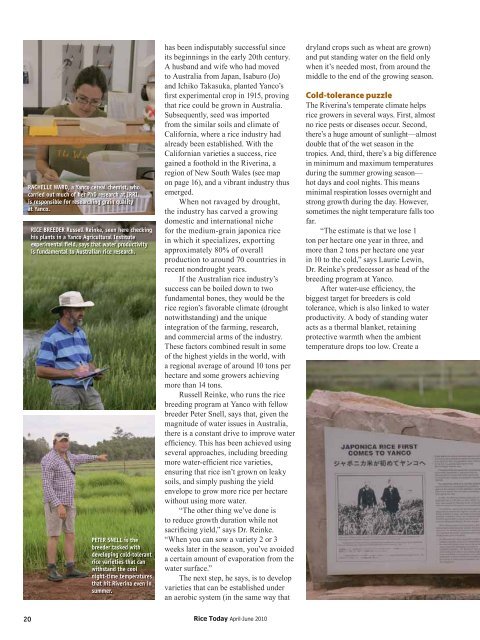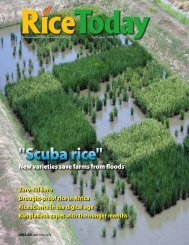RACHELLE WARD, a Yanco cereal chemist, whocarried out much <strong>of</strong> her PhD research at IRRI,is responsible for research<strong>in</strong>g <strong>gra<strong>in</strong></strong> qualityat Yanco.RICE BREEDER Russell Re<strong>in</strong>ke, seen here check<strong>in</strong>ghis plants <strong>in</strong> a Yanco Agricultural Instituteexperimental field, says that water productivityis fundamental to Australian rice research.PETER SNELL is thebreeder tasked withdevelop<strong>in</strong>g cold-tolerantrice varieties that canwithstand the coolnight-time temperaturesthat hit River<strong>in</strong>a even <strong>in</strong>summer.has been <strong>in</strong>disputably successful s<strong>in</strong>ceits beg<strong>in</strong>n<strong>in</strong>gs <strong>in</strong> the early 20th century.A husband and wife who had movedto Australia from Japan, Isaburo (Jo)and Ichiko Takasuka, planted Yanco’sfirst experimental crop <strong>in</strong> 1915, prov<strong>in</strong>gthat rice could be grown <strong>in</strong> Australia.Subsequently, seed was importedfrom the similar soils and climate <strong>of</strong>California, where a rice <strong>in</strong>dustry hadalready been established. With theCalifornian varieties a success, ricega<strong>in</strong>ed a foothold <strong>in</strong> the River<strong>in</strong>a, aregion <strong>of</strong> New South Wales (see mapon page 16), and a vibrant <strong>in</strong>dustry thusemerged.When not ravaged by drought,the <strong>in</strong>dustry has carved a grow<strong>in</strong>gdomestic and <strong>in</strong>ternational nichefor the medium-<strong>gra<strong>in</strong></strong> japonica rice<strong>in</strong> which it specializes, export<strong>in</strong>gapproximately 80% <strong>of</strong> overallproduction to around 70 countries <strong>in</strong>recent nondrought years.If the Australian rice <strong>in</strong>dustry’ssuccess can be boiled down to tw<strong>of</strong>undamental bones, they would be therice region’s favorable climate (droughtnotwithstand<strong>in</strong>g) and the unique<strong>in</strong>tegration <strong>of</strong> the farm<strong>in</strong>g, research,and commercial arms <strong>of</strong> the <strong>in</strong>dustry.These factors comb<strong>in</strong>ed result <strong>in</strong> some<strong>of</strong> the highest yields <strong>in</strong> the world, witha regional average <strong>of</strong> around 10 tons perhectare and some growers achiev<strong>in</strong>gmore than 14 tons.Russell Re<strong>in</strong>ke, who runs the ricebreed<strong>in</strong>g program at Yanco with fellowbreeder Peter Snell, says that, given themagnitude <strong>of</strong> water issues <strong>in</strong> Australia,there is a constant drive to improve waterefficiency. This has been achieved us<strong>in</strong>gseveral approaches, <strong>in</strong>clud<strong>in</strong>g breed<strong>in</strong>gmore water-efficient rice varieties,ensur<strong>in</strong>g that rice isn’t grown on leakysoils, and simply push<strong>in</strong>g the yieldenvelope to grow more rice per hectarewithout us<strong>in</strong>g more water.“The other th<strong>in</strong>g we’ve done isto reduce growth duration while notsacrific<strong>in</strong>g yield,” says Dr. Re<strong>in</strong>ke.“When you can sow a variety 2 or 3weeks later <strong>in</strong> the season, you’ve avoideda certa<strong>in</strong> amount <strong>of</strong> evaporation from thewater surface.”The next step, he says, is to developvarieties that can be established underan aerobic system (<strong>in</strong> the same way thatdryland crops such as wheat are grown)and put stand<strong>in</strong>g water on the field onlywhen it’s needed most, from around themiddle to the end <strong>of</strong> the grow<strong>in</strong>g season.Cold-tolerance puzzleThe River<strong>in</strong>a’s temperate climate help<strong>sr</strong>ice growers <strong>in</strong> several ways. First, almostno rice pests or diseases occur. Second,there’s a huge amount <strong>of</strong> sunlight—almostdouble that <strong>of</strong> the wet season <strong>in</strong> thetropics. And, third, there’s a big difference<strong>in</strong> m<strong>in</strong>imum and maximum temperaturesdur<strong>in</strong>g the summer grow<strong>in</strong>g season—hot days and cool nights. This meansm<strong>in</strong>imal respiration losses overnight andstrong growth dur<strong>in</strong>g the day. However,sometimes the night temperature falls to<strong>of</strong>ar.“The estimate is that we lose 1ton per hectare one year <strong>in</strong> three, andmore than 2 tons per hectare one year<strong>in</strong> 10 to the cold,” says Laurie Lew<strong>in</strong>,Dr. Re<strong>in</strong>ke’s predecessor as head <strong>of</strong> thebreed<strong>in</strong>g program at Yanco.After water-use efficiency, thebiggest target for breeders is coldtolerance, which is also l<strong>in</strong>ked to waterproductivity. A body <strong>of</strong> stand<strong>in</strong>g wateracts as a thermal blanket, reta<strong>in</strong><strong>in</strong>gprotective warmth when the ambienttemperature drops too low. Create a20 Rice Today April-June 2010
variety with high cold tolerance, andyou cut the amount <strong>of</strong> water neededthroughout the grow<strong>in</strong>g season.The breeder tasked with crack<strong>in</strong>g thecold-tolerance puzzle is Dr. Snell.“We’ve got quite high cold toleranceto start with because a lot <strong>of</strong> our stockstarted from Californian material, whichis generally tolerant,” he says. “But,with up to 30 °C between maximumand m<strong>in</strong>imum temperatures <strong>in</strong> summer,we want extreme cold tolerance. We’retalk<strong>in</strong>g about be<strong>in</strong>g able to cope withtemperatures as low as 10 °C at criticalstages <strong>of</strong> the plant’s growth.”Without that sort <strong>of</strong> cold tolerance,the aerobic rice varieties Dr. Re<strong>in</strong>kedescribes will rema<strong>in</strong> noth<strong>in</strong>g more thana nice idea. But, accord<strong>in</strong>g to Dr. Snell,that may be about to change, with apromis<strong>in</strong>g cold-tolerant variety due to bereleased later <strong>in</strong> 2010.Familial bondLeeton rice farmer Rob Houghton (seeA <strong>sunburned</strong> <strong>gra<strong>in</strong></strong> on pages 12-17)suggests that the close relationshipbetween growers and researchers is“the reason that the <strong>in</strong>dustry is asstrong as it is now <strong>in</strong> such hard times.Geographically, we’re <strong>in</strong> a relativelysmall area, so it’s almost a familyA PLAQUE commemorates the site <strong>of</strong> the first Japaneserice planted <strong>in</strong> New South Wales <strong>in</strong> 1915.environment. One <strong>of</strong> the benefits is thatany outcomes <strong>of</strong> R&D are very quicklyimplemented on the farm. The l<strong>in</strong>es <strong>of</strong>communication are very crisp, so whenthere’s a new development it’s put outthere straight away. There’s good accessto our R&D people, everyone knowswho’s do<strong>in</strong>g what and there’s plenty<strong>of</strong> opportunity for growers to availthemselves <strong>of</strong> the latest technologies andtheories.”Added to this, the farmershave an excellent relationship withSunRice. In fact, “relationship” isan understatement—the farmers areshareholders <strong>in</strong> the bus<strong>in</strong>ess, which,as well as handl<strong>in</strong>g all process<strong>in</strong>g andmarket<strong>in</strong>g operations, guarantees to buyrice at a fair price each season. SunRicealso ensures product quality by sell<strong>in</strong>gpure seed to every farmer each season,rather than hav<strong>in</strong>g farmers reta<strong>in</strong> theirown seed.The third relationship <strong>in</strong> the triangleis between SunRice and the Yancoresearchers. Dr. Re<strong>in</strong>ke says, “One <strong>of</strong> themost productive l<strong>in</strong>ks we have with the<strong>in</strong>dustry is through the people <strong>in</strong>volved<strong>in</strong> market<strong>in</strong>g the rice. We get togetherwith them regularly, and we get feedbackabout what’s happen<strong>in</strong>g <strong>in</strong> world markets,what the limitations are <strong>in</strong> the varietieswe currently have, and what marketsmight want <strong>in</strong> the future.”Collaborat<strong>in</strong>g with IRRIDr. Re<strong>in</strong>ke expla<strong>in</strong>s that when he firstarrived at Yanco, the <strong>in</strong>dustry workedwith only two pr<strong>in</strong>cipal quality types<strong>of</strong> rice: long- and medium-<strong>gra<strong>in</strong></strong>japonica. S<strong>in</strong>ce then, that numberhas grown to seven. The first stage<strong>of</strong> the diversification process was thedevelopment <strong>of</strong> a fragrant, s<strong>of</strong>t-cook<strong>in</strong>glong-<strong>gra<strong>in</strong></strong>, similar to Thai jasm<strong>in</strong>e rice.This was followed by Arborio-stylevarieties for use <strong>in</strong> such dishes as risottoand paella, then s<strong>of</strong>t-cook<strong>in</strong>g short-<strong>gra<strong>in</strong></strong>rice aimed at the East Asian market.Next was a firm-cook<strong>in</strong>g South Asianstylelong-<strong>gra<strong>in</strong></strong> and, more recently, alarger dimensioned medium-<strong>gra<strong>in</strong></strong> for theMiddle Eastern market.One unexpected effect <strong>of</strong> thedrought is that several <strong>of</strong> the Yancoresearchers have become <strong>in</strong>volved <strong>in</strong><strong>in</strong>ternational projects—several <strong>of</strong> which<strong>in</strong>volve IRRI—aimed at improv<strong>in</strong>g riceLAURIE LEWIN, former head <strong>of</strong> breed<strong>in</strong>g at Yanco.production <strong>in</strong> develop<strong>in</strong>g countries <strong>in</strong>Asia. As traditional fund<strong>in</strong>g has dropped<strong>of</strong>f, opportunities have emerged throughthe Australian Centre for InternationalAgricultural Research, which operatesas part <strong>of</strong> Australia’s <strong>of</strong>ficial overseas aidprogram.“We maximize our relationshipwith IRRI at every opportunity,” saysDr. Re<strong>in</strong>ke. “Historically, though, ithasn’t been easy because IRRI works ontropical rice. I can talk to the breedersthere about techniques, but shar<strong>in</strong>ggermplasm (plant genetic material) isn’tso valuable. But Melissa Fitzgerald’sappo<strong>in</strong>tment really heralded a new era <strong>in</strong>l<strong>in</strong>kages with IRRI because, with <strong>gra<strong>in</strong></strong>quality, it doesn’t matter if it’s tropical ortemperate. Gra<strong>in</strong> quality and the genesfor quality are similar across tropical andtemperate varieties <strong>of</strong> rice.”Secur<strong>in</strong>g commercial needsOne <strong>of</strong> the key roles for Mike Hedditch,general manager, Grower Services forSunRice, is ensur<strong>in</strong>g that the R&Dprogram addresses the commercial needs<strong>of</strong> the bus<strong>in</strong>ess. Failure to do this, hesays, ultimately means a failure to meetthe needs <strong>of</strong> the farmers themselves.“We supply an enormous amount<strong>of</strong> our <strong>in</strong>tellectual property to the R&Dprogram,” he says. “We’re very keento make sure that the rice breed<strong>in</strong>g andthe <strong>gra<strong>in</strong></strong> quality programs <strong>in</strong> particularget the right market signals about thetypes <strong>of</strong> varieties they need to developand about the quality <strong>of</strong> the <strong>gra<strong>in</strong></strong> thatconsumers want.”Rice Today April-June 201021

















